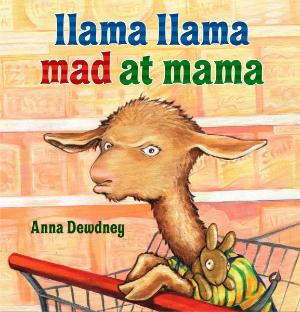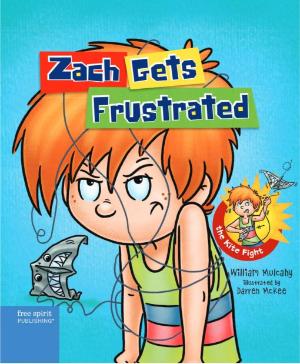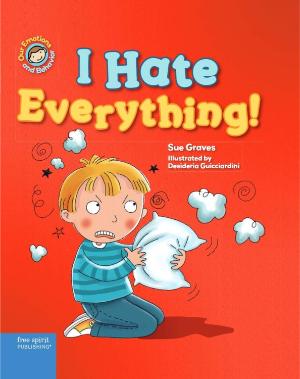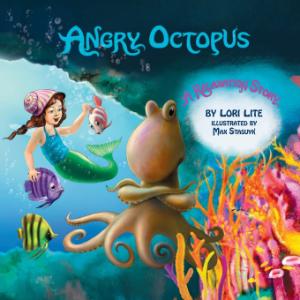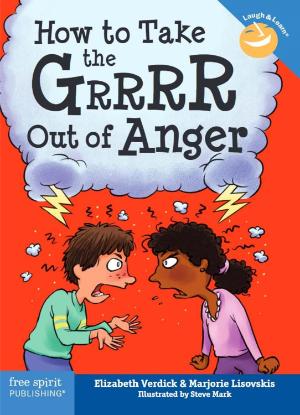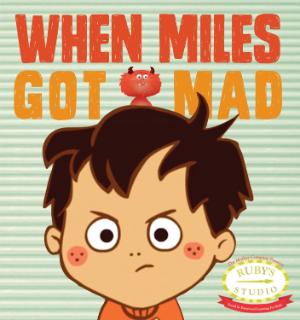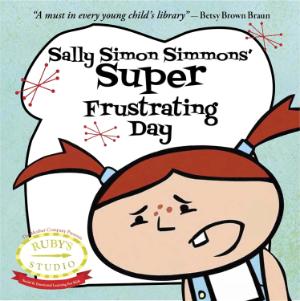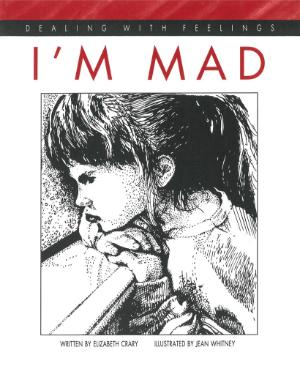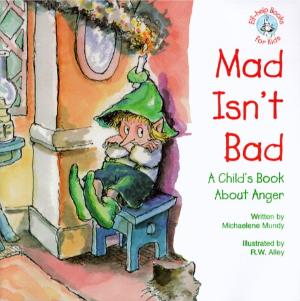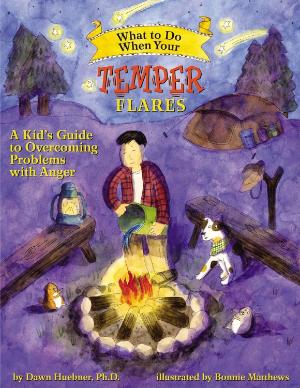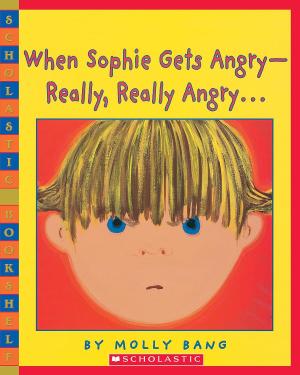
All kids -- like all humans -- get angry. Anger is the body's "fight" response, to keep us safe when we feel threatened. When someone trespasses against our boundaries, we get angry.
But humans don't only get angry in response to outside threats. When something happens today that reminds us of a past upset, we get angry to protect ourselves -- even if the threat today isn't really much of a threat. That's why our three year old's defiance triggers our rage.
We also get angry to fend off upsetting feelings. So when our own fear, hurt, disappointment, pain or grief scares us, we tend to lash out. The anger doesn't get rid of the hurt, but it makes us feel less powerless and temporarily numbs the pain. This explains why anger is part of the grieving process.
So humans mobilize against any perceived threat (even our own upset feelings) by attacking.
That's true for kids as well, of course. And because kids don't have a context for their upsets, a small disappointment can seem like the end of
the world. Worse yet, since they don't have a fully developed frontal cortex to help them self-regulate, children are even more prone to lashing
out when they're angry. (Doesn't it seem crazy that we expect them to handle anger constructively, when so often we adults don't?)
Sometimes attacking makes sense when we're angry, but only when there's actually a threat. That's rare. Most of the time when kids get angry, they want to attack their little brother (who broke their treasured memento), their parents (who disciplined them "unfairly"), their teacher (who embarrassed them) or the playground bully (who scared them.)
Luckily, as children's brains develop, they gain the capacity to manage their anger constructively -- IF they live in a home where anger is handled in a healthy way.
What does "constructive" handling of anger look like for a child (or even an adult)?
- Controlling aggressive impulses.
When parents accept and empathize with the child's emotions, the child learns that emotions aren't dangerous and can be felt -- without necessarily being acted on. As we accept our child's anger and remain calm, she lays down the neural pathways and learns the emotional skills to calm herself down and communicate how she feels, without hurting people or property. By the time they're in kindergarten, kids should be able to tolerate the flush of adrenaline and other "fight" chemicals in the body without acting on them by clobbering a playmate. (Note: It's not unusual for kindergartners to still hit siblings.) - Acknowledging the anger, as well as the more threatening feelings under the anger.
If you can keep yourself from getting triggered and acknowledge why your child is upset, his anger will begin to calm. That will help him feel safe enough to feel the more vulnerable emotions driving the anger. Once the child can let himself experience his grief over the broken treasure, his hurt that his mother was unfair, his shame when he didn't know the answer in class, or his fear when his classmate threatened him, those feelings begin to heal. As those vulnerable feelings begin to fade away, he no longer needs his anger to defend against them -- so the anger vanishes.
By contrast, if we don't help kids feel safe enough to feel those underlying emotions, they will just keep losing their tempers, because they don't have any other way to cope with the upsets inside them. These kids often seem to have "a chip on their shoulder" because they lug around resentments; a feeling that life is against them. They're always ready to get angry. - Constructive Problem-Solving.
Eventually, the goal is for your child to use the anger as an impetus to change things as necessary so the situation won't be repeated. This may include moving his treasures out of little brother's reach, or getting parental help to deal with the bully. It may also include acknowledging his own contribution to the problem, so that he resolves to do a better job following his parents' rules, or to come to class more prepared.
With your help, your child will learn to calm himself when he's angry so that he can express his needs and wants without attacking the other person, either physically or verbally. He'll learn to see the other person's side of the issue and to look for win/win solutions to the problem, rather than just assuming that he's right and the other person is wrong.
Obviously, it takes years of parental guidance for kids to learn these skills. If parents are able to help kids feel safe enough to express their anger and explore the feelings underneath, kids are increasingly able to control their outbursts so they can express their anger appropriately and move into constructive problem-solving during the grade-school years.
How can parents help kids learn to manage their anger?
Here are ten tips for teaching your child healthy anger management in everyday life.
1. Start with yourself.
You're probably good at staying calm when things are going well. What takes heroic effort is staying calm when things get turbulent. But yelling at an angry child reinforces what she's already feeling, which is that she is in danger. (You may not see why she would think she's in danger when she just socked her little brother, but a child who is lashing out is a child who is feeling threatened and defensive.) So your anger will only make the storm worse.
If you're in the habit of shouting at your kids, know that you are modeling behavior that your child will certainly copy. It can be tough to stop yourself from yelling at your child, but if you give in to that temptation, you can't expect your child to learn to control himself. Your child learns from watching you how to handle disagreements and conflict.
2. Get good at de-escalating.
Your job when your child is angry is always to restore calm, because kids can only learn and understand how to "do better" when they're calm.
Your calm presence, even when he's mad, helps your child feel safe. And that's what helps him develop the neural pathways in the brain that shut off the "fight or flight" response and allow the frontal cortex, the "reasoning brain," to take over.
3. Remember that all feelings are allowed.
When humans are angry, they don't calm down until they feel heard. So when your child expresses anger, the best thing you can do is listen and acknowledge how upset he is and why. You obviously don't have to agree with his reasons to recognize that he's angry and has a right to be.
So in that moment, don't tell your child to calm down, or to act appropriate. That just makes your child escalate in an attempt to get you to hear. Instead, open the door to communication: "You must be so mad to speak to me that way. I want to hear about this. Can you tell me so I can hear, without yelling at me?"
Later, of course, once your child calms down, you can talk about appropriate tone or language: "You were so angry earlier, that you yelled at me. I always want to hear when you're upset, and I will always try to help. You never need to yell at me to get me to listen. Right?" Usually at this point, since your child now feels heard, they will spontaneously apologize.
No, you're not encouraging bad behavior. Remember, all emotions are acceptable, only actions need to be limited. When you ask kids to "stuff" their emotions, those feelings are no longer under conscious control. So they're going to pop out unregulated, making it more likely that your child will have a short fuse. If the emotions are allowed, the child can accept them, instead of trying to repress them. That gives her enough cognitive control over the feelings so that she can start putting them into words instead of hitting. And over time her verbal expression becomes more modulated and appropriate.
4. Give your child ways to manage his angry impulses in the moment.
Kids need skills to manage their anger in the moment. When your child is calm, make a list with him of constructive ways to handle emotion. Let him do the writing, or add pictures, so he feels some ownership of the list. Post the list on the refrigerator and model using it yourself when you're mad: "I'm getting annoyed, so I'm checking our MAD list. Oh, I think I'll put on some music and dance out my frustration!" Here are some ideas to get you started:
- Teach your child to use their "PAUSE" button by breathing in for four counts through the nose, and then out for eight through the mouth.
- Grab two squishy balls; hand her one, and demonstrate working out annoyance on the squishy ball.
- Put on music and do "an angry dance."
- To keep from hitting, kids can clap their arms around their bodies (so each hand ends up on the opposite shoulder or side) and yell something like "Mom!" or "Stop!"
- Young children often find it helpful to stomp their feet when they're mad. Don't worry, it's better than kicking their sister or the wall, and over time they will start using words.
- With a child who is a bit older, you can suggest that she draw or write on paper what she is angry about, and then fiercely rip it into tiny pieces.
One note about expressing the anger physically. Remember that what's healing isn't acting out the aggression, which can actually make the person more angry (because it signals that there's an emergency!) The body may benefit from discharging tension, but that could happen from dancing. What's really helpful for your child is that he gets to show you just how upset he is, so he feels understood. So if your child wants to clobber something (in lieu of acting out his anger toward a person), say "You are showing me just how mad you are about this! I see! Wow!"
5. Help your child be aware of her "warning signs."
Once kids are in the full flush of adrenaline and the other "fight or flight" neurotransmitters, they think it's an emergency, and they're fighting for their lives. At that point, managing the angry impulses is almost impossible, it's very hard to reach them, and all we can offer is a safe haven while the storm sweeps through them. But if you can help your child notice when she's getting annoyed and learn to calm herself, she'll have many fewer tantrums. When she's little, you'll have to know her cues and take preventive action -- offering some snuggle time, or getting her out of the grocery store. As she gets older, you can point it out to her:
"Sweetie, you're getting upset. We can make this better. Let's all take a deep breath and figure this out together."
"I know this is hard. And you can handle this. I'm here to help."
6. Set limits on aggression.
Allowing feelings does not mean that we allow destructive actions. Kids should never be allowed to hit others, including their parents. When they do, they are always asking for us to set limits and help them contain their anger. Say "You can be as mad as you want but no hitting. I will keep us all safe. You can tell me how mad you are without hurting me."
Some children really need to struggle against something when they're angry. It's fine to let them struggle against your hands, or even your holding arms, if that's what they want, but take off your glasses, and don't let yourself get hurt.
Similarly, don't let kids break things in their fury. That just adds to their guilt and sense that they're a bad person. Your job is to serve as a safe "container" while you witness your child's upsets.
7. Don't send a child away to "calm down" by herself.
Your goal when your child is angry or upset is to restore a sense of safety, which requires your calm presence. Remember that kids need your love most when they "deserve it least." Instead of a "time out," which gives kids the message that they're all alone with these big, scary feelings, try a "time in," during which you stay with your child and help him move through his feelings. You'll be amazed at how your child begins to show more self control when you adopt this practice, because he feels less helpless and alone. You don't have to say much; just "I'm right here ... You're safe ... I'm listening." Why every home needs a "Calm-Down Corner."
8. Restore connection.
Your child needs to know that you understand and are there to help. If you know what's going on, acknowledge it:
"You are so angry that your tower fell."
If you don't know, say what you see: "You are crying so hard.... I see how upset you are."
Give explicit permission: "It's ok, everyone needs to cry (or gets mad, or feels very sad) sometimes. I will stay right here while you show me your sads and mads." If you can touch your child, do so to maintain the connection: "Here's my hand on your back. You're safe. I'm here."
If he yells at you to go away, say:
"I hear you saying for me to go away so I am moving away, over here. I won't leave you all alone with these big feelings. I will be right over here when you are ready for a hug."
9. Do preventive maintenance to help your child work through the emotions that come up daily.
Every parent needs to develop some "emotion-coaching" habits that help your child feel safe and connected, and that help her work through the emotional challenges that all children encounter in daily life. Those practices are:
- Empathy: Respond to everything the child expresses with empathy and respect, even when you set limits. (You won't be able
to be empathic 24/7. Just work on increasing your ratio.)
- Special Time: Spend a minimum of 15 minutes one-on-one with each child daily, just connecting and enjoying the child.
- Routines: So your child knows what to expect, which helps kids feel safer.
- Accept all Emotions your child expresses, and make it safe for him to cry when he needs to.
- Snuggle Time: Every morning, night and when needed in between, to increase your child's feeling of safety.
- Roughhousing and Laughter: Make sure that each child gets a daily chance to belly-laugh for at least 10 minutes, preferably by being physically active with him.
Here's a whole post on preventive maintenance.
10. Help your child develop emotional intelligence.
Kids who are comfortable with their feelings are more able to manage their anger constructively. There's a whole section on this website on emotional intelligence.
Some kids, unfortunately, don't feel safe expressing their uncomfortable feelings. Sometimes parents haven't allowed them to cry, so they get angry instead. Sometimes they have parents who discount or even ridicule their fears or disappointments. Sometimes they've been sent to their rooms to "calm down" and never received the help they needed to handle their upsets. Sometimes the pain or grief just feels too overwhelming. They try hard to repress their fears, jealousies, and anxieties, but repressed feelings have a way of popping out unmodulated, as when an otherwise loving preschooler suddenly hits the baby. These kids live in fear of their feelings. To fend off this reservoir of fear, grief, or other pain, these kids get angry -- and they stay angry. When this happens, a child may benefit from professional help.
How do you know when your child needs help handling anger? Look for these ten signs.
- She can't control her aggressive impulses and hits people (other than siblings), past the age of six.
- Frequent explosive outbursts, indicating that he is carrying a full 'tank" of anger and other upsets, that's always ready to spill over.
- She is constantly reflexively oppositional (and she isn't two years old.)
- He doesn't acknowledge his role in creating the situation, instead feeling constantly victimized and "picked on."
- She frequently loses friends, alienates adults, or is otherwise embroiled in interpersonal conflict.
- He seems preoccupied with revenge.
- She threatens to hurts herself physically (or actually does so).
- He damages property regularly.
- She repeatedly expresses hatred toward herself or someone else.
- He hurts animals or smaller children who are not siblings.
When a child has "anger management issues" it means that he is terrified of those pent-up feelings under the anger (fear, hurt, grief.) To defend against those vulnerable feelings that he thinks will destroy him, he hardens his heart and clings to the anger as a defense. That's when kids develop a chip on their shoulder. They seem to be trying to drive you away, but it's really a cry for help.
Begin by using the ideas in this article to support your child. Start talking about emotions in your home, using the books below as a starting place to begin a discussion. If you don't feel like things are changing after a few months of good effort, don't hesitate to seek professional help. An experienced therapist can help the child work through those deeper feelings, and develop more ability to manage his emotions. But in general, I recommend that parents go into counseling along with their child. You don't want your child to feel that he's broken so you're taking him to get "fixed." You want everyone in the family to learn how to communicate better, so everyone feels loved and gets their needs met. A good therapist who will meet with you and your child together can help you do that.
Recommended Resources
PLEASE NOTE: These books are Amazon links with photos of the books. If you are not seeing them on your page, it may be that your browser is not picking them up. Please try a different browser. Enjoy!


